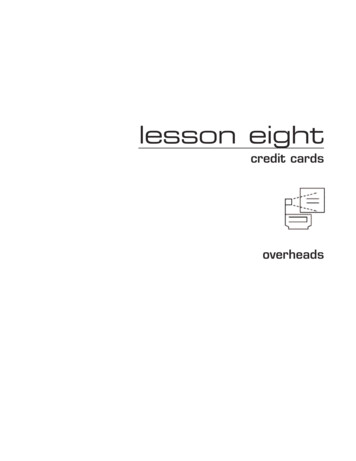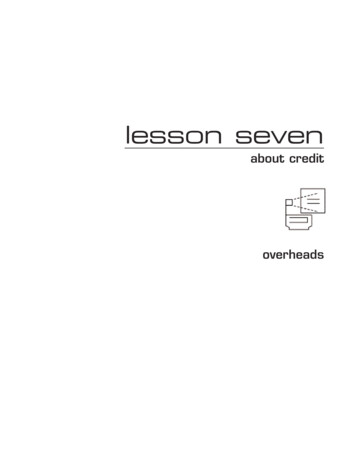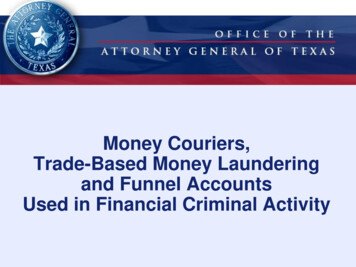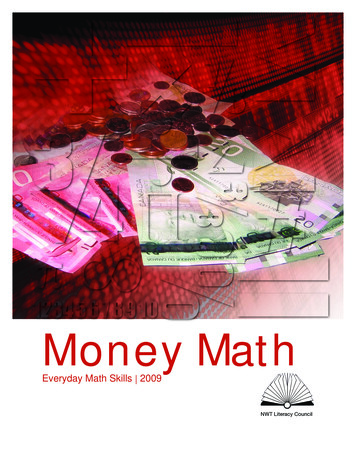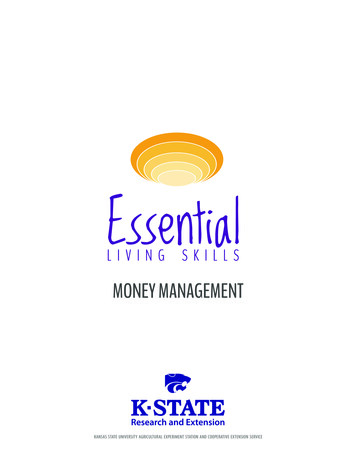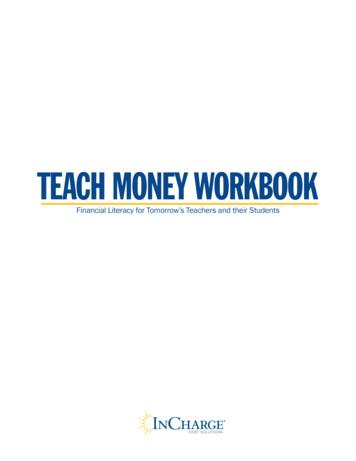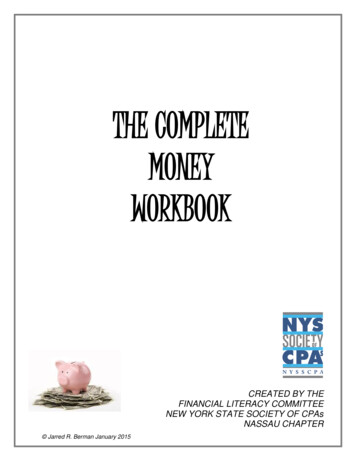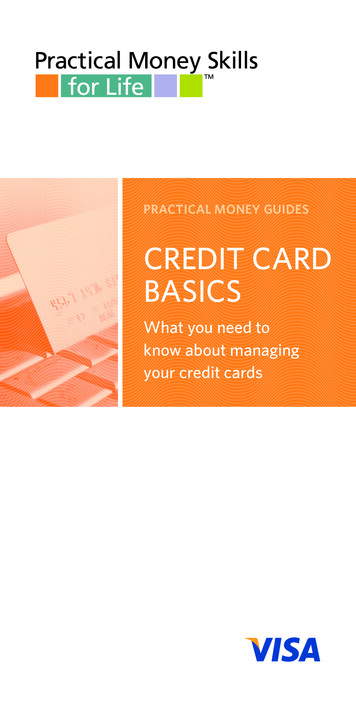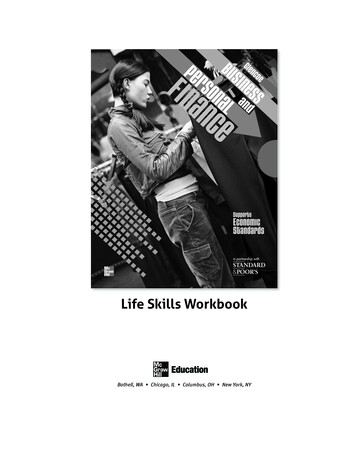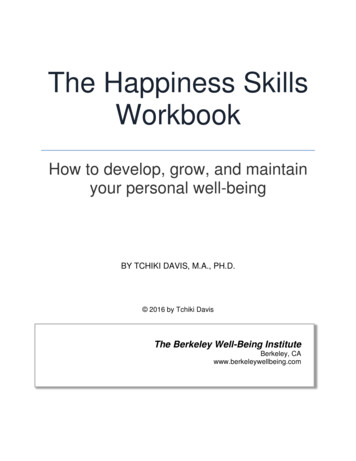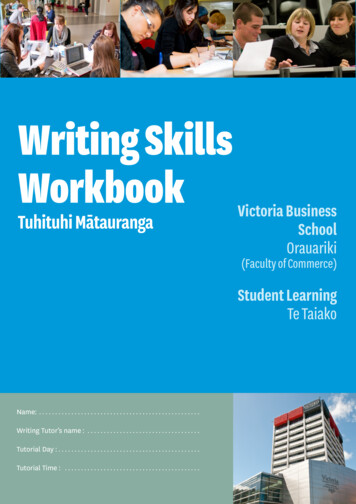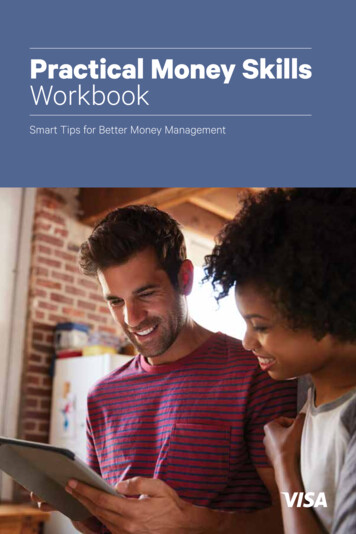
Transcription
Practical Money SkillsWorkbookSmart Tips for Better Money Management
Getting StartedWhether you are just starting out on your own or you’ve been managingyour own money for years, basic budgeting, saving and credit skillscan help you gain control over your financial future. This workbook isdesigned to help you learn basic budgeting skills and understand howfinancial services and products work so you can manage your moneywith confidence.The earlier you start using good money management practices, the easierit will be to stick with them and the more positive impact you’ll have onyour financial future. This workbook provides an opportunity to becomebetter at managing your money starting today, so you can enjoy life, freeof undue financial stress.That's why Visa has put together this program. We want you to understandthe basics of managing money wisely. Our hope is that after you completethis workbook, you'll have a better understanding of living within a budget,the nuances of banking and how to handle credit responsibly — skillsthat can help you create a more secure financial future.Table of ContentsBudgeting BasicsMastering Your MoneyMaking a PlanMonthly Expense TrackerBalancing Your Budget22568Online and Mobile BankingYour Money and Online BankingCashless Payments101012Checking AccountGetting Started: Banking OptionsGood Record-Keeping141417Debit CardsDebit Versus Credit: What’s the Difference?Things to Remember181819Savings AccountSaving for a Rainy DaySavings Worksheet202021Understanding CreditWhat is a Credit Score?How to Improve Your ScoreCredit Cards – Know Your LimitTake Care with Credit2222242528Test YourselfGlossary of TermsOnline Resources3234Back CoverPractical Money Skills Workbook 1
Budgeting BasicsMastering Your MoneySix Saving IdeasIn order to manage your money, you need to have a plan. That is why creating a budget,and sticking to it, is a critical foundation for financial order and stability. By trackingyour income and expenses, you will be better able to distinguish between needs andwants and ensure that you’re living within your means.Know Your IncomeThe first step in this process is to know how much you make, including your salary,wages and tips. Figure out how much you have coming in each month and use thechart below to track your monthly income. Make sure to include only income you cancount on — no gifts or bonuses.IncomeEstimated AmountActual AmountIncome #1Income #2Other IncomeTotalTotal IncomeTip: You can track your expenses using personal financebudgeting apps, which make budgeting more convenientthan ever.Tracking Your ExpensesTracking your expenses is another key step toward financial responsibility. To begin,get receipts or take note of everything you spend over the month and record it weeklyin the Budgeting Worksheet on page 9. Many people are surprised how unplannedpurchases can add up. By making a habit of tracking your expenses, you can see whereyour money is going, curb unnecessary spending and increase your savings.If you find you are spending more than you make, now is the time to start spending lessand setting aside more. Here are a few of the many ways you can save. Pay yourself first: Determine a set amount of money to put away every month andtreat it like any other bill. Put away part of every paycheck — ideally at least 10-15%— and watch your savings grow. Save on food: Plan out the week's meals with your budget in mind. Try making dishesthat rely on the same staples to save on your grocery bill. Just make sure to mix thingsup so you won’t get bored; this could make you more likely to splurge on eating out. Reconsider coffee: That daily coffee run could be costing you over 850 per year,not including tip. Cutting back on these small daily expenses or purchasing aninexpensive coffee maker could help you save in the long run. Save your windfalls: Did you receive an unexpected bonus at work, an inheritanceor a tax refund? Instead of depositing the money into your checking account whereyou may be likely to spend it, put some or all of it into your savings account for safekeeping. Visit your local library: Save money by borrowing books from your library instead ofbuying them. Most libraries have e-books and movies you can stream online so youdon’t even have to leave home to enjoy them. Weatherproof your home: Visit your local hardware store to buy supplies to fixdrafty windows that may be letting warm air out in the winter and cool air out in thesummer, a factor that could be impacting your utilities bill. Share living expenses. Living with a roommate is a great way to cut monthly costsin half. Get the best rates. Compare costs from different insurance companies to ensureyou’re getting the best rate. Plan for big expenses. Try to put money aside when you know big expenses, likeholiday gifts, a car repair or a family trip, are coming up. Use credit wisely. Carefully consider how quickly you can pay off purchases beforeusing credit, as high monthly payments can take a toll on your budget.2 Practical Money Skills WorkbookPractical Money Skills Workbook 3
Budgeting BasicsConsider sharing livingexpenses with a roommate.It’s a great way to cutmonthly costs in half.Making a PlanCompare costs fromdifferent insurancecompanies.Make a list beforeshopping for groceries.It will help you avoidpricey impulse buys.Track your expenses for a month with the worksheet on pages 6 and 7. Look at allof your expenses by category, estimate your monthly income, see what you’ve spentand make a spending plan for the coming month. Tracking your expenses will allowyou to compare your discretionary purchases (items you want) to non-discretionarypurchases (items you need) so you can cut back on unnecessary spending andincrease your savings. (See example on the opposite page.)Make sure to balance your budget every month to ensure you’re not spending morethan you’re making. If you find you’re spending too much on discretionary purchaseslike entertainment or clothes, you can cut back the next month. Keep in mind thatnon-discretionary expenses, like housing and utility bills, will take a little more planningto reduce. If you find the process difficult at first, don’t worry. A personal budget is awork in progress, and spending within your budget will soon become second nature.Budgeting to Meet Your Goals Prioritize your savings goals. Consider what you would like to achieve financially,whether it’s making a down payment on a house, going on a summer vacation orpaying off your credit card debt. Set short-term, medium-term and long-term goals. Short-term goals, like setting upan emergency fund, require less than six months to achieve; medium-term goals, likebuying a car, take six months to a year; and long-term goals, like saving for retirement,take longer than a year. Consider what you need to do in order to accomplish these goals within yourprojected time frame. You can set monthly savings goals to help you work towardsyour end goal over time.Budgeting AppsUse credit cards with care.High monthly payments canimpact your budget.4 Practical Money Skills WorkbookConsider looking into free budgeting apps, which allow you to link your bank accountand separate your expenses into different categories like rent, loans, groceries andentertainment costs. You can set a budget for each category to keep your expensesorganized and controlled.Practical Money Skills Workbook 5
Budgeting BasicsMonthly Expense TrackerWeek 1Week 2Week 3Week pensesCableCell onalCar talGroceriesFoodPublic TransportationChildcareDining althcare529 PlansTotalMonthlyTotalOtherTransportationWeek 4TotalTotalNew ParentsWeek 3InsurancePrescriptionsMonthlyTotalWeek 2EyesInternetMisc.Week 1Credit CardsSavingsMonthlyTotalMisc.Total6 Practical Money Skills WorkbookPractical Money Skills Workbook 7
Budgeting BasicsBalancing Your BudgetOnce you get in the habit of tracking your expenses, you’re ready to start balancingyour budget. Take a look at how much you’re spending every month in each category.This will give you a clear picture of where your money is going, so you can see whetheryou’re making more than you’re spending. Balancing your budget can also help youreduce your spending in one category to cover upcoming needs or wants in another.For example, if you anticipate needing a repair made to your car, you can cook at homea few more nights a week instead of eating out in order to pay for the repair withoutexceeding your budget. You can also consider getting an extra source of funds, liketaking on a side gig in your spare time, to supplement your income so you can coverextra expenses without compromising your budget.Budgeting WorksheetThis budget worksheet will help you set up your personal budgeting system. Enter yourestimated income and expenses in the first column. After a month, compare the totalsto your actual expenses and income. How far off were you? If you’re spending beyondyour means, make adjustments and track your spending again the next month.IncomeEstimated AmountActual AmountIncome #1Income #2Other IncomeTotalTotal IncomeExpensesEstimated AmountActual AmountLivingTransportationNew ParentsMedicalPersonalFoodOtherTip: Set aside 15 minutes each week to make sure thatyour expenses are matching up with your online bankstatement and that your budget is on track.TotalTotal ExpensesTotal Income–Total Expenses Net IncomeTo use our online Budget Planner,visit practicalmoneyskills.com/reworkbudget8 Practical Money Skills WorkbookPractical Money Skills Workbook 9
Online and Mobile BankingYour Money and Online BankingOnline and mobile banking are convenient and valuable because they can help keepyou aware of your spending with just a few clicks. Just remember that it’s important tokeep track of debits and deposits that may not have cleared yet on your online bankingstatement. You can also use peer-to-peer payment service apps, which allow you tomake fast, easy, cashless transactions with friends and others. For example, you canpay back a friend for lunch or pay for a babysitter — all without a trip to the ATM orwaiting for a check to clear. All of these tools help you keep a closer eye on your money,which is great for both budgeting and security. Although today’s financial institutionshave sophisticated fraud protection services; the more you stay on top of your dailytransactions, the faster you can identify any suspicious activity.Bill PayFunds TransferOne of the best qualities of online banking is that it allows you to transfer fundselectronically, which eliminates the risk of someone stealing your checks from themail. You can transfer money between your personal accounts and outside accounts,such as car loans, credit cards and sometimes other contacts’ accounts — like yourlandlord’s. It may also allow family members and others to send you money instantly.While there are many apps and payment services on the market, utilizing your bank’sservices is convenient and safe.You can also use automatic funds transfers to help you save more. This service allowsyou to automatically transfer a portion of your paycheck or checking account balanceinto a savings account or investment fund each pay period or month. You can typicallyset this up online, at your local branch or by using an investment savings app.With online banking, it’s easier to schedule and pay bills on time, and to track yourexpenses quickly and efficiently. You can easily list payees such as your landlord, phoneprovider or insurance company. By identifying your payee name, address and accountnumber (if applicable), you can send payments from your account almost instantaneously.If you choose to, you can set up your account so bills are paid automatically at apredetermined date or so a reminder will be sent to you when a payment is due. Manybanks will have your bills sent to you online depending on whether or not the payeeoffers electronic billing.Bill tracking apps allow you to link your bank account to pending bills so that you canpay your landlord or utility vendors with ease. You can pay your bills directly from theapp to avoid late fees and stay organized.StatementsAnother useful feature is the ability to view your statements online, including paststatements. It’s convenient, paperless and it deters mail fraud and identity theft.10 Practical Money Skills WorkbookPractical Money Skills Workbook 11
Online and Mobile BankingCashless PaymentsCashless transactions offer a convenient, safe and fast way to pay. Common ways tomake electronic payments include digital wallets, wearables like smart watches andonline payments systems for digital money transfers and other transactions; these serveas an electronic alternative to paper methods like cash and checks. A digital wallet, forexample, allows you to make cashless payments from your card through your phone.More and more stores are beginning to accept payments like these.Cashless payments are often made via mobile transaction. For example, you can placea mobile order before ever reaching a store or send gifts to friends and family fromyour smartphone. With contactless credit and debit cards, you can tap your card ata store’s checkout terminal, your card is scanned and you get confirmation that thetransaction is complete via a beep, checkmark or green light. There is no fumbling withcash or waiting for change. You can also choose the way you pay, whether it’s with acontactless card, payment-enabled phone, smart watch or other device.Online Banking BenefitsAvailable 24/7Email and mobileAccess from anyaccount alertsdeviceBudgeting tools andautomated spreadsheetsView, download and print onlinestatementsEasy fund transfersView images of checksAnywhere accessto accounts onsmartphones andmobile devicesEnvironmentally friendly, withelectronic, paperless transactionsBill pay feature can ensure thatbills are paid on time12 Practical Money Skills WorkbookPractical Money Skills Workbook 13
Checking AccountGetting Started: Banking OptionsAbout Checking and Savings AccountsTo open a checking or savings account, you can apply online or visit a bank or creditunion's branch. Once your account is opened, you’ll be able to enroll in online bankingvia the bank or credit union’s website and use your login information to download andstart using the mobile banking app. It’s a good idea to comparison shop across financialinstitutions and look for minimal fees and the best interest rates on savings, as well asall the tools and technology that suit your needs.The building blocks of budgeting and online banking are your checking and savingsaccounts. Before you open accounts, it’s important to understand why they exist andhow they work. Your checking account is the central hub for your money and allowsyou to access funds in several different ways: with checks, ATMs, your debit card, atbanks and via online banking. Your savings account, which can also be accessed withyour debit card or at your banking center, is a great place to save for a rainy day orfuture expenses, like a car or house.ONLINE & MOBILEDEBIT CARDCHECKING ACCOUNTngCheckiBCHECKSklistnt ChecATMAccouCheck Safety and Securityhlynt montouour accalance ynsansactiomatic trotuarule foedour schKnow ysk of feeacKeep trLookBANKuresrity featucesrout foeity immactivpicioussustroepIf you are going outside of your bank or credit union to get checks printed, make sureyou do your homework on a third-party check provider. A reputable check printeroffers security features built into the check. Items to look for are a padlock icon on theprinter’s website to the left of the web address, micro printing, a security screen andwarning boxes that appear on the front and back of the check. Do not put privateinformation on checks like your Social Security Number, your driver’s license numberor any unnecessary personal data.diatelyR14 Practical Money Skills WorkbookPractical Money Skills Workbook 15
Checking AccountWriting a CheckWhile you may not need to use checks often, knowing how to write one is an importantskill. When you write a check, funds won’t be debited from your account until thepayee cashes or deposits the check. For this reason, it’s important to keep track of anychecks you write so that you don’t accidentally overdraw your account. Most mobilebanking apps will allow you to photograph and upload the check for deposit.Write the name of theperson or company you’repaying. Never leave thisline blank.Write out theamount of thecheck in words.Put the date here.Consider including anote to remind you whatthe payment is for.Part of responsible financial management is good record-keeping, and with automatedbill payments, this is fast and easy. Your online account is a great organizational tool,but it can be just as important for you to keep a hard or digital copy of your financesfor your own day-to-day records and budgeting purposes. Once you get in the habitof tracking expenses, it should be easier to monitor any outstanding checks you mayhave written, in addition to monthly automatic payments or other pending payments.A problem many people experience at some point in their lives is overdrawing theiraccount. Every time you overdraw, you incur an insufficient funds fee. One way to avoidthis is to stay on top of your account balance and keep good records. You can also linkyour checking account to other accounts, such as a savings or credit account, foroverdraft protection. With this in place, money will be automatically transferred fromyour savings or credit account if you don’t have enough money in your checking accountto cover a check or withdrawal.Sign here.Zero cents.16 Practical Money Skills WorkbookGood Record-KeepingWrite the amount ofthe check in numbers.Practical Money Skills Workbook 17
Debit CardsDebit Versus Credit: What's the Difference?Things to RememberA debit card looks similar to a credit card whether you are presenting it for payment orusing mobile banking services. It offers a lot of the same features as a credit card, butit’s different in a few important ways. One difference is where the money is withdrawnfrom when you purchase something. A debit card is tied directly to a checking account,so when you make a purchase with that card, money is withdrawn from your account.When you use most credit cards to purchase goods or services, the charge is made toa line of credit by the company that issued the card. One exception is secured orprepaid credit cards, which require you to make an initial deposit and allow you tospend only up to 100% of the deposit amount.How to use your debit card wisely:While most credit cards allow you to purchase now and pay later, debit card transactionsare paid instantly, not in the future. When you get your monthly credit card bill, you payback a portion or all of it. While credit cards have a limit on how much you can borrow,debit cards generally only let you access the amount of funds available in your account.Many of the same features and protections offered by credit cards are also offeredby debit cards. One example is zero liability, which means you are generally not liablefor unauthorized purchases on your debit card if you notify your financial institutionright away.Note that different types of debit card transactions may be processed differently. Somedebit your account within 24 hours, while others may take two to three days.Using your debit card, cash, check or a secured credit card for most purchases canbe a good way to stay financially responsible as it can keep you from making impulsebuys. Credit cards are a convenient way to pay and can be a useful way to build credit,but it is best to use them for budgeted purchases you can pay off immediately. Look for the symbol of a pro
Understanding Credit 22 What is a Credit Score? 22 How to Improve Your Score 24 Credit Cards – Know Your Limit 25 Take Care with Credit 28 Test Yourself 32 Glossary of Terms 34 Online Resources Back Cover Whether you are just starting out on your own or you’ve been managing your own money for years, b
